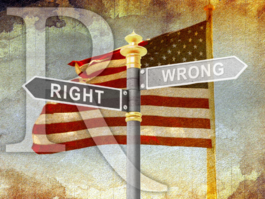Voters Now Favor GOP By 13 Points for House, Senate
With the midterms elections now less than a year away, Republicans have a double-digit lead in their bid to recapture control of Congress.
The latest Rasmussen Reports national telephone and online survey finds that, if the elections for Congress were held today, 51% of Likely U.S. Voters would vote for the Republican candidate, while 38% would vote for the Democrat. Just three percent (3%) would vote for some other candidate, but another eight percent (8%) are not sure. (To see survey question wording, click here.)
In January 2018, before voters handed Democrats their first House majority in eight years, Democrats held an eight-point advantage (45% to 37%) in the generic ballot question. That margin narrowed as the November 2018 midterms neared, and was a statistical dead heat – Republicans 46%, Democrats 45% – in the final poll before Democrats won a slim House majority while Republicans maintained control of the Senate.
The 13-point edge for Republicans in the latest poll is larger than Democrats enjoyed at any time during the 2018 midterm campaign, due both to greater GOP partisan intensity and a wide advantage among independents. While 89% of Republican voters say they would vote for their own party’s candidate, only 77% of Democrats would vote for the Democratic candidate. Among voters not affiliated with either major party, 48% would vote Republican and 26% would vote Democrats, with another 17% undecided.
(Want a free daily e-mail update? If it’s in the news, it’s in our polls). Rasmussen Reports updates are also available on Twitter or Facebook.
The survey of 2,500 U.S. Likely Voters was conducted on November 8-11, 2021 by Rasmussen Reports. The margin of sampling error is +/-2 percentage points with a 95% level of confidence. Field work for all Rasmussen Reports surveys is conducted by Pulse Opinion Research, LLC. See methodology.
Fifty-six percent (56%) of whites, 30% of black voters and 47% of other minorities would vote Republican if the election were held today. Sixty-three percent (63%) of black voters, 33% of whites and 38% of other minorities would vote Democrat.
Slightly more women voters than men favor Republican control of Congress.
Voters under 40 favor Democrats by a margin of 49% to 40%, but majorities of older voters – 56% of those ages 40-64 and 57% of those 65 and older – would vote Republican.
Breaking down the electorate by income brackets, Republicans enjoy their largest advantage – 55% to 37% – among voters earning between $50,000 and $100,000 a year.
The Republican advantage is smaller among voters who attended college, and Democrats have a narrow edge – 46% to 44% – among those with postgraduate degrees.
Entrepreneurs and retirees strongly favor the GOP, and most private sector workers would vote Republican, while government employees slightly favor Democrats.
Voters increasingly distrust reporting about politics, and most think the media are less aggressive in questioning President Joe Biden than they were with former President Donald Trump.
The sagging popularity of President Joe Biden has political consequences, as more than half of voters say they would vote against Biden-endorsed candidates in their state. An endorsement by former President Donald Trump would be more valuable, particularly with independent voters.
Additional information from this survey and a full demographic breakdown are available to Platinum Members only.
Please sign up for the Rasmussen Reports daily e-mail update (it’s free) or follow us on Facebook. Let us keep you up to date with the latest public opinion news.
The survey of 2,500 U.S. Likely Voters was conducted on November 8-11, 2021 by Rasmussen Reports. The margin of sampling error is +/-2 percentage points with a 95% level of confidence. Field work for all Rasmussen Reports surveys is conducted by Pulse Opinion Research, LLC. See methodology.
Rasmussen Reports is a media company specializing in the collection, publication and distribution of public opinion information.
We conduct public opinion polls on a variety of topics to inform our audience on events in the news and other topics of interest. To ensure editorial control and independence, we pay for the polls ourselves and generate revenue through the sale of subscriptions, sponsorships, and advertising. Nightly polling on politics, business and lifestyle topics provides the content to update the Rasmussen Reports web site many times each day. If it's in the news, it's in our polls. Additionally, the data drives a daily update newsletter and various media outlets across the country.
Some information, including the Rasmussen Reports daily Presidential Tracking Poll and commentaries are available for free to the general public. Subscriptions are available for $4.95 a month or 34.95 a year that provide subscribers with exclusive access to more than 20 stories per week on upcoming elections, consumer confidence, and issues that affect us all. For those who are really into the numbers, Platinum Members can review demographic crosstabs and a full history of our data.
To learn more about our methodology, click here.





